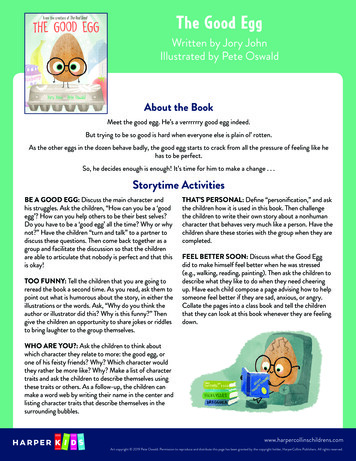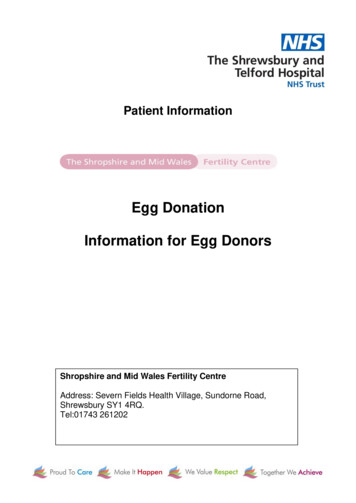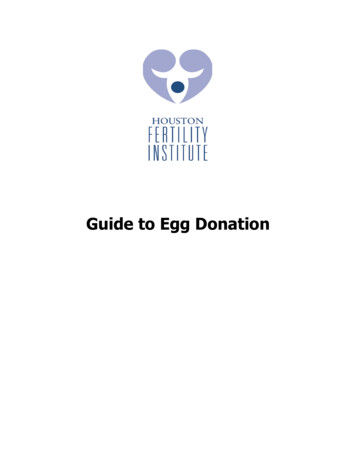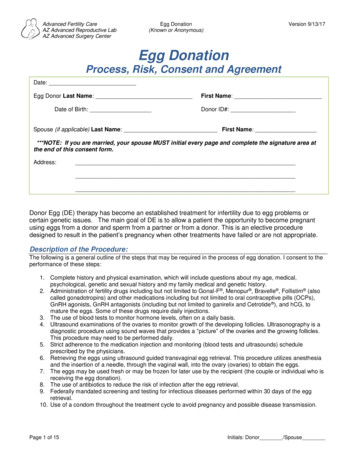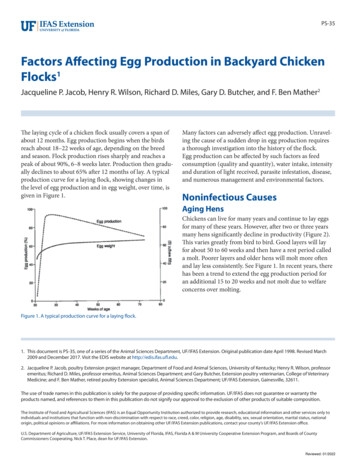
Transcription
PS-35Factors Affecting Egg Production in Backyard ChickenFlocks1Jacqueline P. Jacob, Henry R. Wilson, Richard D. Miles, Gary D. Butcher, and F. Ben Mather2The laying cycle of a chicken flock usually covers a span ofabout 12 months. Egg production begins when the birdsreach about 18–22 weeks of age, depending on the breedand season. Flock production rises sharply and reaches apeak of about 90%, 6–8 weeks later. Production then gradually declines to about 65% after 12 months of lay. A typicalproduction curve for a laying flock, showing changes inthe level of egg production and in egg weight, over time, isgiven in Figure 1.Many factors can adversely affect egg production. Unraveling the cause of a sudden drop in egg production requiresa thorough investigation into the history of the flock.Egg production can be affected by such factors as feedconsumption (quality and quantity), water intake, intensityand duration of light received, parasite infestation, disease,and numerous management and environmental factors.Noninfectious CausesAging HensChickens can live for many years and continue to lay eggsfor many of these years. However, after two or three yearsmany hens significantly decline in productivity (Figure 2).This varies greatly from bird to bird. Good layers will layfor about 50 to 60 weeks and then have a rest period calleda molt. Poorer layers and older hens will molt more oftenand lay less consistently. See Figure 1. In recent years, therehas been a trend to extend the egg production period foran additional 15 to 20 weeks and not molt due to welfareconcerns over molting.Figure 1. A typical production curve for a laying flock.1. This document is PS-35, one of a series of the Animal Sciences Department, UF/IFAS Extension. Original publication date April 1998. Revised March2009 and December 2017. Visit the EDIS website at http://edis.ifas.ufl.edu.2. Jacqueline P. Jacob, poultry Extension project manager, Department of Food and Animal Sciences, University of Kentucky; Henry R. Wilson, professoremeritus; Richard D. Miles, professor emeritus, Animal Sciences Department; and Gary Butcher, Extension poultry veterinarian, College of VeterinaryMedicine; and F. Ben Mather, retired poultry Extension specialist, Animal Sciences Department; UF/IFAS Extension, Gainesville, 32611.The use of trade names in this publication is solely for the purpose of providing specific information. UF/IFAS does not guarantee or warranty theproducts named, and references to them in this publication do not signify our approval to the exclusion of other products of suitable composition.The Institute of Food and Agricultural Sciences (IFAS) is an Equal Opportunity Institution authorized to provide research, educational information and other services only toindividuals and institutions that function with non-discrimination with respect to race, creed, color, religion, age, disability, sex, sexual orientation, marital status, nationalorigin, political opinions or affiliations. For more information on obtaining other UF/IFAS Extension publications, contact your county’s UF/IFAS Extension office.U.S. Department of Agriculture, UF/IFAS Extension Service, University of Florida, IFAS, Florida A & M University Cooperative Extension Program, and Boards of CountyCommissioners Cooperating. Nick T. Place, dean for UF/IFAS Extension.Reviewed: 01/2022
is important in digestion. Chlorine also plays a role inmaintaining osmotic balance in body fluids. Birds deficientin chlorine are more nervous, showing increased sensitivityto sudden noise.CALCIUMFigure 2.Improper NutritionLaying chickens require a completely balanced diet tosustain maximum egg production over time. Inadequatenutrition can cause hens to stop laying. Inadequate levels ofenergy, protein or calcium can cause a drop in egg production. This is why it is so important to supply laying henswith a constant supply of nutritionally balanced layer food.Feeding whole grains, scratch feeds, and table scraps willcause the birds’ diet to become imbalanced and inadequate.Many times these imbalances can cause other problems likeoviductal prolapse. Prolapse may occur when the bird istoo fat and/or an egg is too large and the bird’s reproductivetract is expelled with the egg. Prolapse usually causespermanent damage to the hen and is fatal in many cases.Omission of Feed IngredientsSALTAnimals have an innate desire to consume salt. Feeding asalt-deficient diet will lead to increased feather pecking anda decline in egg production.Most animal feeds will contain added salt, usually inthe form of sodium chloride. Iodine is rarely added as aseparate ingredient. Instead, iodized salt is routinely used.Cobalt iodized salt is often used in diets for swine andruminants, and this can be used without any problems forpoultry. This type of salt is usually blue.Sodium is an essential nutrient, playing a major role inmaintaining body fluid volume, blood pH, and properosmotic relationships. A continuously low intake of salt cancause a loss of appetite. Sodium deficiencies adversely affectutilization of dietary protein and energy and interfere withreproductive performance.Chlorine is also an essential nutrient. Hydrogen chloride(HCl) released from the true stomach (proventriculus)Factors Affecting Egg Production in Backyard Chicken FlocksThe eggshell is composed primarily of calcium carbonate.The pullet’s requirement for calcium is relatively low duringthe growing period, but when the first eggs are produced,the need is increased at least four times, with practically allof the increase being used for the production of eggshells.Inadequate calcium consumption will result in decreasedegg production and lower eggshell quality.Hens store calcium in medullary bone, a specialized bonecapable of rapid calcium turnover. As calcium stores aredepleted, bones become brittle. In severe cases, hens areunable to stand. The condition is known as caged-layerfatigue. Birds on the ground or on litter floors recyclecalcium and phosphorus through consumption of feces anddo not have caged-layer fatigue.Calcium can be supplied in the diet as either groundlimestone or oyster shell. Particle size affects calciumavailability. Usually the larger the particle size, the longerthe particle will be retained in the upper digestive tract.This means that the larger particles of the calcium sourceare released more slowly, and this may be important for thecontinuity of shell formation, especially in the dark periodwhen birds do not ordinarily eat.Periodically, dolomitic limestone is offered to the feedindustry. However, dolomitic limestone (which is used inthe steel industry) should never be used in poultry diets.Dolomitic limestone contains at least 10% magnesium andthis complexes with calcium or competes with calciumfor absorption sites in the intestines. The consequence offeeding dolomitic limestone is induced calcium deficiency.Young birds should not be fed a high calcium layer dietbecause the calcium/phosphorus ratio will be unbalanced,resulting in increased morbidity or mortality.VITAMIN DVitamin D is required for normal calcium absorptionand utilization. If inadequate levels of vitamin D are fed,induced calcium deficiency quickly results and egg production decreases.Feed grade vitamin D comes in two forms, D2 and D3. Inmost animals, both are equally potent. In birds, however,2
D3 is substantially more active than D2. In poultry diets,therefore, vitamin D must be supplied in the form of D3.absorption and can reduce egg production, shell quality,and/or hatchability.PROTEINIn addition to its function in bone, phosphorus plays aprimary role in carbohydrate metabolism, is active in fatmetabolism, and helps to regulate the acid-base balance ofthe body.Dietary requirements for protein are actually requirementsfor the amino acids that constitute the protein. There are22 amino acids in body proteins, and all are physiologicallyessential. Poultry cannot synthesize some of these or cannotsynthesize them rapidly enough to meet the metabolicrequirement. Therefore, these amino acids must be suppliedin the diet. Amino acid requirements vary considerablyaccording to the productive state (i.e., growing, laying eggs,etc.), age, type, breed, and strain. Methionine is the aminoacid most often deficient in laying rations.When pullets begin laying, there is an increase in protein,vitamin, and mineral requirements per day due to deposition in the egg. If dietary protein is too low or the aminoacid requirements are not met, poor egg production andhatchability will occur.FATDietary fat is a source of energy and of linoleic acid, an essential fatty acid. A deficiency of linoleic acid will adverselyaffect egg production. Dietary fats also serve as “carriers” offat-soluble vitamins, and some fat is necessary for absorption of vitamins. In fact, impairment of the absorption offat-soluble vitamins (A, D, E, and K) is the most seriousconsequence of a dietary deficiency of fat.ToxicosesSALTAlthough the salt requirement of birds is relatively low,adequate levels are essential, and excessive amounts arehighly toxic and reduce egg production. Birds require asensitive balance between necessary and toxic levels of salt(see Table 1).Excess dietary salt intake readily causes wet droppings andwet litter. Several feed ingredients, such as fish meal, corngluten meal, meat meal, whey, and sunflower meal, containhigh levels of sodium. When such ingredients are used,the level of supplemental salt (NaCl) in the diet must bereduced.PHOSPHORUSThe nutritional role of phosphorus is closely related tothat of calcium. Both are constituents of bone. The ratioof dietary calcium to phosphorus affects the absorptionof both these elements; an excess of either one impedesFactors Affecting Egg Production in Backyard Chicken FlocksVITAMIN DExcess vitamin D3 leads to increased calcium absorptionresulting in hypercalcemia, which may reduce egg production. Most animal species appear to be able to tolerate 10times their vitamin D3 requirement for long periods oftime. For short periods of time, poultry can tolerate up to100 times their requirement. An excess of vitamin D3 in thediet, therefore, is unlikely.MYCOTOXINSMolds can produce mycotoxins that adversely affect eggproduction and general health. They can interfere with theabsorption or metabolism of certain nutrients, dependingon the particular mycotoxin. Apparent calcium and/or vitamin D3 deficiencies can occur when mycotoxincontaminated feeds are given to laying hens. In addition,some have hormonal effects which can cause a decline inegg production.The major mycotoxin of concern with corn is aflatoxin, produced by the mold Aspergillus flavus. The mold infects cornboth in the field and in storage. Aflatoxin fluoresces underultraviolet light, so its presence can be detected by examining grain under “black light”. Other mycotoxins sometimesassociated with corn and other grains are zearalenone (F-2toxin), ochratoxin, T-2 toxin, vomitoxin, and citrinin. Morethan 300 mycotoxins have been identified.BOTULISMBotulism is an acute intoxication caused by consumptionof a neurotoxin produced by the bacteria Clostridiumbotulinum. It commonly occurs when birds consumedecomposing carcasses, spoiled feed, or other decayingorganic materials. Ponds and other stagnant water sourcesare often areas of decaying materials that may contain thistoxin.OTHER TOXINSNumerous plants are toxic to varying degrees if plant partsor seeds are consumed by the bird. Production, hatchability,growth, and livability may be reduced. Examples of theseplants include crotalaria, nightshade, coffeeweed, cottonseeds, chick peas, vetches, and many ornamentals. Other3
potential causes of problems include pesticides, herbicides,disinfectants, fertilizers, drugs, antibiotics, and otherchemicals, including oils and antifreeze.AnticoccidialsAnticoccidials (to prevent coccidiosis) are commonly usedin diets for replacement pullets, meat birds, and youngbreeding stock that are reared on litter floors.NICARBAZINNicarbazin is an anticoccidial drug that reduces reproductive performance when it’s inadvertently added to layeror breeder diets at normal anticoccidial levels. The yolkmembranes are weakened, resulting in mottling of the yolk.Nicarbazin fed to brown-egg layers turns their eggshellswhite within 48 hours, although this is completely reversible when the product is withdrawn from the feed. Evenlow levels of nicarbazin can cause some loss in shell color,mottling of egg yolks (see Fact Sheet PS-24, Egg Quality),and a decline in hatchability.MONENSINMonensin has been the most successful of the anticoccidials. Monensin, and other ionophore anticoccidials, have anadverse effect on egg production when used in conjunctionwith low protein diets.Management MistakesOUT OF FEEDIf hens are out of feed for several hours, a decline in eggproduction will probably occur. The amount of decline willbe related to the time without feed. Be sure that all the birdshave access to an adequate supply of a complete feed whichmeets all their nutritional requirements.Feed stored on the farm longer than two weeks maybecome moldy. If feed becomes wet it should be discarded.In addition, vitamin potency decreases with prolongedstorage.OUT OF WATERWater is often taken for granted, and yet it is probably themost essential nutrient. Water is by far the single greatestconstituent of the body, and, in general, represents about70% of total body weight. Access to water is very important,and a lack of water for several hours will probably cause adecline in egg production. Hens are more sensitive to a lackof water than a lack of feed.Factors Affecting Egg Production in Backyard Chicken FlocksThe amount of water needed depends on environmentaltemperature and relative humidity, diet composition, andrate of egg production. It has been generally assumed thatbirds drink approximately twice as much water as theamount of feed consumed on a weight basis, but waterintake varies greatly, especially in hot weather.INADEQUATE DAY LENGTHHens need about 14 hours of day length to maintain eggproduction. The intensity of light should be sufficient toallow a person to read newsprint at bird level. The decreasing day length during the fall and shorter day lengths inthe winter would be expected to cause a severe decline, oreven cessation, in egg production unless supplemental lightis provided. When production ceases, the birds may alsoundergo a feather molt. Hens exposed to only natural lightwould be expected to resume egg production in the spring.HIGH HOUSE TEMPERATURESHigh environmental temperatures pose severe problemsfor all types of poultry. Feed consumption, egg production,egg size, and hatchability are all adversely affected underconditions of severe heat stress. Shade, ventilation, anda plentiful supply of cool water help reduce the adverseeffects of heat stress.EctoparasitesAn ectoparasite is a parasitic organism that feeds on theexterior of the body of the host.NORTHERN FOWL MITEThe northern fowl mite (Ornithonyssus sylviarum) is themost common of the poultry mites. Refer to the publicationENY-290, External Parasites of Poultry, for information onidentification and control of northern fowl mites.Northern fowl mites are blood suckers and are irritating topoultry. Anemia occurs in heavily parasitized birds, reducing feed efficiency, egg production, and ability to withstandand overcome diseases.LICESeveral species of chewing lice may be found on chickens,especially those in small flocks or on range. Refer to thepublication ENY-290, External Parasites of Poultry, forinformation on identification and control of lice.Chicken lice feed on dry scales, feathers, or scabs on theskin. As lice crawl over the bird, their mouth parts andsharp claws scratch the skin. The constant irritation causesthe bird to become nervous and behave abnormally, causing4
a general unthriftiness and unkempt appearance in thebird. Egg production in infested flocks may drop as muchas 10%, although some heavy infestations have caused eggproduction to fall as much as 20%.the chickens to have poor growth, poor feed conversion,and a precipitous fall in egg production. Fowl pox mayaffect any age bird. It is transmitted by direct contact withan infected chicken or by mosquitoes.FLEASFor more information on fowl pox, refer to publicationVM65, Prevention and Control of Fowl Pox in BackyardChicken Flocks.Stick-tight fleas are sometimes a severe problem in homeflocks and may be difficult to prevent or eradicate. The adultfemale flea attaches to the skin around the face and head,causing severe irritation and, in some cases, blindness.Refer to the publication ENY-290, External Parasites ofPoultry, for information on identification and control ofstick-tight fleas.EndoparasitesAn endoparasite is a parasite that lives and feeds inside thehost animal.Heavy infestations of endoparasites can cause unthriftiness,poor feed efficiency, poor growth, reduced egg production,and mortality in severe infestations. Infected birds may alsobe more susceptible to various diseases and stresses.NEMATODESNematodes, or roundworms, are elongated, cylindrical,unsegmented endoparasites. There are many species ofroundworms, each tending to infect a specific area of thegastrointestinal tract. Refer to publication PS-18, NematodeParasites of Poultry, for identificationand control ofnematodes.TAPEWORMSTapeworms (cestodes) are white or yellowish, ribbon-like,segmented flat worms. They vary in size from 0.17 to 12inches in length. Although tapeworms do not produceextensive lesions or damage to the intestines, they arenutritional competitors. A cestode does not digest its ownfood. Instead, it anchors itself to the inner wall of the bird’sintestines, letting its segmented body dangle in the flow ofdigested material, absorbing nutrients before they can beutilized by the host. A variety of commercially availableanthelmintics will effectively and safely eliminate bothnematodes and cestodes from poultry.DiseasesFowl PoxFowl pox is a viral disease of chickens characterized byscab-like lesions on the skin of the unfeathered body partsand/or on diphtheritic (wet) membranes lining the mouthor air passages. Infection with the fowl pox virus will causeFactors Affecting Egg Production in Backyard Chicken FlocksCoccidiosisCoccidiosis is a protozoan disease characterized by enteritisand diarrhea in poultry. Unlike the organisms which causemany other poultry diseases, coccidia are almost universallyfound wherever chickens are raised. Coccidiosis outbreaksvary from very mild to severe infections.Individual strains of coccidia attack birds differently,resulting in diverse symptoms. The overall symptoms maybe one or more of the following: bloody droppings, highmortality, general droopiness, emaciation, a marked drop infeed consumption, diarrhea, and a drop in egg productionin layers.It is common to add a coccidiostat in the feed of broilers. Inaddition, live vaccines are currently available.Infectious BronchitisInfectious bronchitis is a highly contagious respiratorydisease. The disease is caused by a virus which is moderately resistant but can be destroyed by many commondisinfectants.Infectious bronchitis occurs only in chickens (infectiousbronchitis is different from quail bronchitis which affectsbobwhite quail). All ages of chickens are susceptible toinfectious bronchitis. In laying hens it is characterizedby respiratory signs (gasping, sneezing, coughing) and amarked decrease in egg production. Egg quality is alsoadversely affected. Low egg quality and shell irregularities(soft-shelled or misshapen) may persist long after anoutbreak. Chickens that have had infectious bronchitis,especially during the first week of life, may never be goodlayers.There is no effective treatment for infectious bronchitis,although broad spectrum antibiotics for 3 to 5 days may aidin controlling secondary bacterial infections. Vaccines canbe used for prevention, but they are only effective if theycontain the right serotypes of virus for a given area. Infectious bronchitis vaccine is often combined with Newcastlevaccine in the same vial.5
Newcastle DiseaseAvian EncephalomyelitisNewcastle disease is caused by a virus. The viruses varyin pathogenicity and are classified as lentogenic (mildlyvirulent), mesogenic (moderately virulent), and velogenic(markedly virulent).Avian encephalomyelitis (epidemic tremors) is a viraldisease usually affecting young poultry. It is characterizedby incoordination and tremors, especially of the head andneck in chicks, and elevated mortality levels. Chicks thatrecover may later develop cataracts after sexual maturity. Inaffected hens, decreases in egg production and hatchabilityare noted.Newcastle disease is characterized by a sudden onset andrapid spread through the flock. In adult laying hens clinicalsigns can include depression, loss of appetite, decreasedwater consumption, and a dramatic decline in egg production. Production may drop to zero. Newcastle disease runsits course in 10 to 14 days, but the hens do not come backinto full production for 5 to 6 weeks.There is no treatment for Newcastle disease. Antibioticscan be given for 3 to 5 days to prevent secondary bacterialinfections. Chickens and turkeys can be immunized againstNewcastle disease by vaccination.Avian InfluenzaAvian influenza is a viral disease affecting the respiratory,digestive, and/or nervous systems of many species of birds.Avian influenza viruses are classified based on severity ofdisease, ranging from apathogenic to highly pathogenic.The mildly pathogenic form produces listlessness, respiratory signs (sneezing, coughing), and diarrhea. The levelof mortality is usually low. The highly pathogenic formof avian influenza produces facial swelling, cyanosis, anddehydration with respiratory distress. Dark red/whitespots (cyanosis/ischemia) develop on the legs and combsof chicks. Mortality can range from low to near 100%. Thedecrease in egg production is related to the severity of thedisease and can be severe.There is no specific treatment for avian influenza.Recovery is rather spontaneous. Birds slaughtered sevendays after infection often have no significant increase incondemnations.Infected flocks will be quarantined by the state. Quarantineis continued until the flock is depopulated. The course ofthe disease is 10 to 14 days, but recovered birds continueto shed the avian influenza virus in feces for 3 or 4 weeks.Eggs from layers are safe to eat, but the shell should bewashed and sanitized. The poultry litter or manure shouldbe composted before application to cultivated lands.For more information on avian influenza refer to publication PS-38, Avian Influenza in Poultry.Factors Affecting Egg Production in Backyard Chicken FlocksLaying hens seldom show clinical signs when infectionis going through the flock. However, good productionrecords often reveal a slight drop in egg production (5% to20%) lasting no more than two weeks. In breeding flocks, acorresponding decrease in hatchability is also noted.There is no effective treatment. All replacement breeder andlayer pullets should be immunized.Mycoplasma gallisepticum InfectionMycoplasma gallisepticum infection (chronic respiratorydisease, PPLO infection, airsacculitis, MG) is characterizeby respiratory distress (coughing, sneezing, snicks, rales,discharge from eyes and nose). Feed consumption and eggproduction decline in laying hens. Mortality is usually low,but there may be many unthrifty birds.The organism may be present in a flock and cause nodisease until triggered by stress, e.g., changes in housing,management, nutrition, or weather.Many broad spectrum antibiotics have been used fortreatment and will suppress losses. However, relapses oftenoccur when treatment is discontinued. Most antibioticsare given in feed or water, preferably in water. Tylosineand tetracyclines have been used extensively for treatment. Injectable antibiotics may be more effective ifthe disease is advanced and if the flock is small enoughto be treated individually. FDA withdrawal periods forrespective medications used must be strictly observed toavoid residual chemicals in the eggs and meat. Live andinactivated vaccines also are commonly used to reduce theadverse effects of the disease.Fowl CholeraFowl cholera is an infectious bacterial disease of poultry.With an acute outbreak, sudden unexpected deaths occurin the flock. Laying hens may be found dead on the nest.Sick birds show anorexia, depression, cyanosis, rales,discharge from eyes and nose, white watery or greenmucoid diarrhea, and egg production is decreased.6
As fowl cholera becomes chronic, chickens develop abscessed wattles and swelling of joints and foot pads. Cheesypus may accumulate in the sinuses under the eyes.Flocks can be treated with a sulfa drug. Sulfa drugs are notFDA approved for use in pullets older than 14 weeks or forcommercial laying hens. Sulfa drugs cause residues in meatand eggs. Prolonged use of sulfa drugs is toxic and causesa decrease in production in laying hens. Antibiotics can beused, but require higher levels and longer medication tostop the outbreak.SummaryThere are numerous factors which may adversely affectegg production in backyard chicken flocks. If a drop inegg production occurs, investigate the cause by answeringquestions that follow. Also refer to Table 1, submit sick andrecently dead birds to a state diagnostic lab, and/or consultwith your local UF/IFAS Extension agent or a veterinarian.1. How old are the birds?2. How much feed are the birds consuming daily?Where fowl cholera is endemic, live and/or inactivatedvaccines are recommended. Do not start vaccinating forfowl cholera until it becomes a problem on the farm and adiagnosis is confirmed.3. Has the level of feed consumption changed lately?Infectious Coryza6. How much light do the birds receive daily? Has itchanged?Coryza is a respiratory disease of chickens. Commonclinical signs include swelling and puffiness around the faceand wattles, a thick sticky discharge with a characteristicoffensive odor from the nostrils, labored breathing, andrales. There is a drop in feed and water consumption as wellas egg production.Sulfadimethoxine (Albon) is the preferred treatment forinfectious coryza. If Albon fails or is not available, sulfamethazine, sulfamerazine, or erythromycin (Gallimycin)can be used as alternative treatments. The sulfa drugs arenot FDA approved for pullets older than 14 weeks or forcommercial laying hens.A vaccine for infectious coryza is available. It is givensubcutaneously (under the skin) on the back of the neck.Chicks are usually vaccinated four times, starting at 5 weeksof age (i.e., at 5, 9, 15, and 19 weeks with at least 4 weeksbetween injections). Vaccinate again at 10 months of ageand twice yearly thereafter.Other Problems to ConsiderThere are a variety of other problems which can cause anapparent drop in egg production. They include:1. Predators and snakes consuming the eggs.2. Egg-eating by hens in the flock.3. Excessive egg breakage.4. Hens which are able to run free, hiding the eggs insteadof laying in nests.Factors Affecting Egg Production in Backyard Chicken Flocks4. Has there been a change in the type of feed used?5. Is the feed moldy?7. What is the light source?8. What is the condition of the poultry houses?9. Are the birds getting enough clean water?10. What is the condition of the birds?11. How active are the birds?12. What is shell quality like?13. What is interior egg quality like?14. Are there any signs of disease?15. Are the birds crowded?16. Are there any signs of parasites?17. Do the birds have access to different plants?18. Have any pesticides or herbicides been used in the area?State Diagnostic Laboratory:Kissimmee Diagnostic LabUS Postal Address:PO Box 458006Kissimmee, FL 34745-8006Delivery & Service Address:2700 N. John Young ParkwayKissimmee, FL 34741-1266(321) 697-1499(321) 697-1467 Fax7
Table 1. Non-infectious causes of reduced egg production.Causes of DeclineSigns/SymptomsOmission of IngredientsSaltNervous flock, increased pecking, feathers in digestive tractCalciumBirds down in cages, increased incidence of shell-less eggsVitamin D3Increased mortality from calcium depletion, increased shell-less eggsProteinIncreased nervousness, increased mortality (peck outs), poor albumen quality, feather eatingFatLow body weight gains, drop in egg sizeToxicosesSaltIncreased mortality due to urolithiasis, lowered feed intakePhosphorusLower feed intake, soft bones, thin shells, increased shell-less eggsVitamin D3Increased shell-less eggs, soft bonesMycotoxinsNervousness, mouth lesions, fatty livers, biliary hyperplasia in liver tissue, reduced feed intake, thinshellBotulismWeakness, limp neck, neck feathers easy to pull out, prostrationNicarbazinShell-less eggs, loss of pigment of brown eggs, lowered hatch, of fertile eggsMonensinReduced feed consumption, birds lack coordinationAnticoccidialsManagement mistakesOut of feedNervous flock, decreased feed consumptionOut of waterBlue combs, birds gathered around waterersInadequate day lengthUnusual pattern of egg productionHigh ambient temperatureReduced egg size, reduced feed consumption, increased water consumption, pantingEctoparasitesNorthern fowl miteNervousness, finding mites on birds (usually around the cloaca)LiceNervousness, weight loss, reduced feed intakeStick-tight fleasFleas embedded in the fleshy parts of the chicken’s head around the eyes, ulceration and irritationof skin around the eyesNematodes (roundworms)Unthriftiness, poor feed efficiency, increased mortality (in severe infestations)Cestodes (tapeworms)General unthriftiness, dry and unkempt feathers, hearty appetite but weight lossEndoparasitesFactors Affecting Egg Production in Backyard Chicken Flocks8
Table 2. Typical diagnostic signs associated with common diseases and conditions that can cause a drop in egg production.DiseaseSignsFowl poxscab-like
Young birds should not be fed a high calcium layer diet because the calcium/phosphorus ratio will be unbalanced, resulting in increased morbidity or mortality. VITAMIN D Vitamin D is required for normal calcium absorption and utilization. If inadequate levels of vitamin D are fed, induced calcium deficiency quickly results and egg produc-
